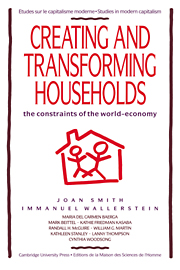Core–periphery and household structures
Published online by Cambridge University Press: 07 June 2010
Summary
We laid out in the introductory chapter how (and why) we reconceptualized the household as an income-pooling unit, with boundaries subject to continuing change. We suggested that households were socially constituted entities subject to pressures deriving from the cyclical rhythms of the world market and from the statemachineries. We argued that ethnicity was a principal modality of socializing household members into particular economic roles, and that these very norms of socialization kept changing under the influence of the multiple pressures generated by the ongoing operation of the world-system. Once formulated, this reconceptualization served as the premise of our collective research.
We proceeded to try to observe how households were constructed and reconstructed in eight “regions” of three parts of the world over a period of a century or so. This empirical work has been presented in Parts II, III, and IV. As the reader will readily observe, we discovered a complex picture, but one which our concepts rendered clearer, or at least so we believe. However, there are no simple conclusions that we can draw from what inevitably was (and was always conceived to be) an exploratory study. We wanted to see if our concepts were usable, and whether they revealed patterns that were prima facie plausible. Obviously, we were plagued by the problem of inadequate and incomparable data. New concepts seldom find already existing data that closely fit their needs of empirical measurement.
- Type
- Chapter
- Information
- Creating and Transforming HouseholdsThe Constraints of the World-Economy, pp. 253 - 262Publisher: Cambridge University PressPrint publication year: 1992
- 3
- Cited by



